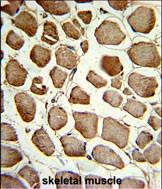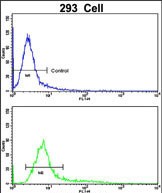CKIP-1 Antibody (N-term)
Purified Rabbit Polyclonal Antibody (Pab)
- 产品详情
- 实验流程
- 背景知识
Application
| WB, IHC-P, FC, E |
|---|---|
| Primary Accession | Q53GL0 |
| Other Accession | A4IFK0 |
| Reactivity | Human |
| Predicted | Bovine |
| Host | Rabbit |
| Clonality | Polyclonal |
| Isotype | Rabbit IgG |
| Calculated MW | 46237 Da |
| Antigen Region | 49-77 aa |
| Gene ID | 51177 |
|---|---|
| Other Names | Pleckstrin homology domain-containing family O member 1, PH domain-containing family O member 1, C-Jun-binding protein, JBP, Casein kinase 2-interacting protein 1, CK2-interacting protein 1, CKIP-1, Osteoclast maturation-associated gene 120 protein, PLEKHO1, CKIP1, OC120 |
| Target/Specificity | This CKIP-1 antibody is generated from rabbits immunized with a KLH conjugated synthetic peptide between 49-77 amino acids from the N-terminal region of human CKIP-1. |
| Dilution | WB~~1:1000 IHC-P~~1:100~500 FC~~1:10~50 E~~Use at an assay dependent concentration. |
| Format | Purified polyclonal antibody supplied in PBS with 0.09% (W/V) sodium azide. This antibody is prepared by Saturated Ammonium Sulfate (SAS) precipitation followed by dialysis against PBS. |
| Storage | Maintain refrigerated at 2-8°C for up to 2 weeks. For long term storage store at -20°C in small aliquots to prevent freeze-thaw cycles. |
| Precautions | CKIP-1 Antibody (N-term) is for research use only and not for use in diagnostic or therapeutic procedures. |
| Name | PLEKHO1 |
|---|---|
| Synonyms | CKIP1, OC120 |
| Function | Plays a role in the regulation of the actin cytoskeleton through its interactions with actin capping protein (CP). May function to target CK2 to the plasma membrane thereby serving as an adapter to facilitate the phosphorylation of CP by protein kinase 2 (CK2). Appears to target ATM to the plasma membrane. Appears to also inhibit tumor cell growth by inhibiting AKT-mediated cell-survival. Also implicated in PI3K-regulated muscle differentiation, the regulation of AP-1 activity (plasma membrane bound AP-1 regulator that translocates to the nucleus) and the promotion of apoptosis induced by tumor necrosis factor TNF. When bound to PKB, it inhibits it probably by decreasing PKB level of phosphorylation. |
| Cellular Location | Cell membrane; Peripheral membrane protein. Nucleus. Cytoplasm Note=Predominantly localized to the plasma membrane through the binding to phosphatidylinositol 3-phosphate (PubMed:14729969). In C2C12 cells, with the absence of growth factor, it is found in the nucleus (PubMed:14729969). It rapidly translocates to the plasma membrane after insulin stimulation (PubMed:14729969). In response to TNF, it translocates from the plasma membrane to the cytoplasm and then to the nucleus accompanied by cleavage by caspase-3 (PubMed:15706351) However, the subcellular location is highly dependent of the cell type, and this explains why it is found exclusively at the plasma membrane, in some type of cells (Probable). {ECO:0000269|PubMed:14729969, ECO:0000269|PubMed:15706351, ECO:0000305} |
| Tissue Location | Abundantly expressed in skeletal muscle and heart, moderately in kidney, liver, brain and placenta and sparingly in the pancreas and lung. Easily detectable in cell lines such as MOLT-4, HEK293 and Jurkat. |
For Research Use Only. Not For Use In Diagnostic Procedures.
Provided below are standard protocols that you may find useful for product applications.
BACKGROUND
CKIP-1 plays a role in the regulation of the actin cytoskeleton through its interactions with actin capping protein (CP). This protein may function to target CK2 to the plasma membrane thereby serving as an adapter to facilitate the phosphorylation of CP by protein kinase 2 (CK2). It appears to target ATM to the plasma membrane and appears to also inhibit tumor cell growth by inhibiting AKT-mediated cell-survival. Also implicated in PI3K-regulated muscle differentiation, the regulation of AP-1 activity (plasma membrane bound AP-1 regulator that translocates to the nucleus) and the promotion of apoptosis induced by tumor necrosis factor TNF. When bound to PKB, it inhibits it probably by decreasing PKB level of phosphorylation.
REFERENCES
Barrios-Rodiles,M., et.al., Science 307 (5715), 1621-1625 (2005)
终于等到您。ABCEPTA(百远生物)抗体产品。
点击下方“我要评价 ”按钮提交您的反馈信息,您的反馈和评价是我们最宝贵的财富之一,
我们将在1-3个工作日内处理您的反馈信息。
如有疑问,联系:0512-88856768 tech-china@abcepta.com.























 癌症的基本特征包括细胞增殖、血管生成、迁移、凋亡逃避机制和细胞永生等。找到癌症发生过程中这些通路的关键标记物和对应的抗体用于检测至关重要。
癌症的基本特征包括细胞增殖、血管生成、迁移、凋亡逃避机制和细胞永生等。找到癌症发生过程中这些通路的关键标记物和对应的抗体用于检测至关重要。 为您推荐一个泛素化位点预测神器——泛素化分析工具,可以为您的蛋白的泛素化位点作出预测和评分。
为您推荐一个泛素化位点预测神器——泛素化分析工具,可以为您的蛋白的泛素化位点作出预测和评分。 细胞自噬受体图形绘图工具为你的蛋白的细胞受体结合位点作出预测和评分,识别结合到自噬通路中的蛋白是非常重要的,便于让我们理解自噬在正常生理、病理过程中的作用,如发育、细胞分化、神经退化性疾病、压力条件下、感染和癌症。
细胞自噬受体图形绘图工具为你的蛋白的细胞受体结合位点作出预测和评分,识别结合到自噬通路中的蛋白是非常重要的,便于让我们理解自噬在正常生理、病理过程中的作用,如发育、细胞分化、神经退化性疾病、压力条件下、感染和癌症。








